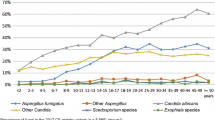Abstract
Objective
Aspergillus fumigatus (A. fumigatus) has emerged as a significant pathogen in patients with cystic fibrosis (CF) and currently is within the top five isolated organisms reported in several international CF patient registries. A. fumigatus has been attributed to disease progression, although its role remains controversial. There is a paucity of reports on its infection dynamics, it was the aim of this study to examine time to first laboratory reports of A. fumigatus acquisition and to correlate this with patient gender and cystic fibrosis transmembrane conductance regulator (CFTR) mutation type.
Methods
One hundred adult (≥ 18 years) CF patients were examined (50 females, 50 males; mean age 24.6 years ± 6.25 (SD), median age 24 years; maximum age 76 years). CFTR mutation groups consisted (i) F508del/F508del homozygous (n = 45), (ii) F508del/other heterozygous (n = 45) and (iii) others (n = 10). CFTR mutation type, patient gender, presence/absence of A. fumigatus and time (months) to first isolation of A. fumigatus were examined.
Results
Microbiological data was examined from 100 patients from birth to present (31/12/2021), equating to 2455 patient years. A. fumigatus was isolated from 66/100 (66%) adult CF patients; (i) F508del/F508del homozygous (82%; 37/45), (ii) F508del/other heterozygous (56%; 25/45) and (iii) others (40%; 4/10). Within the F508del/other heterozygous group, 14 mutations were noted on the second allele, with R560T and R117H collectively accounting for 36% of the second mutations. Four unique allele/allele mutations were noted in the Other Mutations category. There was a trend to a higher A. fumigatus acquisition in F508del/F508del homozygous patients than with F508del/other patients (p = 0.0529). Of the 66 patients who were positive for A. fumigatus, 35(53%) were male and 31(47%) were female. The median and mean time to first isolation of A. fumigatus in all A. fumigatus-positive patients was 119.5 months and 128 months, respectively, shortest time was 12 months, longest time 288 months. There was a statistical significance in time-to-first isolation in relation to CFTR mutation group (p = 0.0272), whereby F508del homozygous individuals had their first isolation of A. fumigatus at 116.8 ± 7.9 months (mean ± standard error of the mean (SEM)) and F508del heterozygous patients had their first isolate of A. fumigatus at 150.4 months ± 13.7 months (mean ± SEM), approximately 2.75 years after their F508del homozygous peers. There was no significant difference (p = 0.12) in time to first acquisiton between males and females, whereby males had their first A. fumigatus isolate at 118 ± 9.4 months, whereas females had their first A. fumigatus isolate at 140 ± 10.8 months. The highest rate of first A. fumigatus isolation was from 4 years until 16 years and by the age of 16 years, approximately 85% of A. fumigatus-positive patients had recorded their first A. fumigatus isolate.
Conclusion
To minimise the risk of first acquisition of A. fumigatus, it is important that infection prevention educational messaging is delivered in the paediatric clinic, to enhance health literacy around A. fumigatus acquisition.



Similar content being viewed by others
References
Shteinberg M, Haq IJ, Polineni D, Davies JC. Cystic fibrosis. Lancet. 2021;397:2195–211. https://doi.org/10.1016/S0140-6736(20)32542-3.
Saiman L, Siegel JD, LiPuma JJ, Brown RF, Bryson EA, Chambers MJ, et al. Infection prevention and control guideline for cystic fibrosis: 2013 update. Infect Control Hosp Epidemiol. 2014;35(Suppl 1):S1-67. https://doi.org/10.1086/676882.
Nagano Y, Millar BC, Johnson E, Goldsmith CE, Elborn JS, Rendall JC, et al. Fungal infections in patients with cystic fibrosis. Rev Med Microbiol. 2007;18(1):11–6. https://doi.org/10.1097/MRM.0b013e3282e1c70a.
Pihet M, Carrere J, Cimon B, Chabasse D, Delhaes L, Symoens F, Bouchara JP. Occurrence and relevance of filamentous fungi in respiratory secretions of patients with cystic fibrosis—a review. Med Mycol. 2009;47(4):387–97. https://doi.org/10.1080/13693780802609604.
King J, Brunel SF, Warris A. Aspergillus infections in cystic fibrosis. J Infect. 2016;5(72 Suppl):S50–5. https://doi.org/10.1016/j.jinf.2016.04.022.
Schwarz C, Eschenhagen P, Bouchara JP. Emerging fungal threats in cystic fibrosis. Mycopathologia. 2021;186(5):639–53. https://doi.org/10.1007/s11046-021-00574-w.
Cystic Fibrosis Canada 2022. The Canadian Cystic Fibrosis Registry 2020 Annual Data Report. Toronto, Canada: Cystic Fibrosis Canada. Available at: https://www.cysticfibrosis.ca/registry/2020AnnualDataReport.pdf. [Last Accessed 06 March 2023].
The Australian cystic fibrosis data registry annual report, 2021. Monash University, Department of Epidemiology and Preventive Medicine, August 2022, Report No 23. Available at: https://www.cysticfibrosis.org.au/getmedia/84536037-f04e-4cf3-b34c-f34031fbf995/ACFDR-2020-Annual-Report-V1-1.pdf.aspx. [Last Accessed 06 March 2023].
UK Cystic Fibrosis Registry 2020 Annual data report. Cystic fibrosis trust. Available at: https://www.cysticfibrosis.org.uk/sites/default/files/2022-05/2020%20Annual%20data%20report%20-%20Version%204.pdf [Last accessed 06 March 2023].
Cimon B, Carrère J, Chazalette JP, Giniès JL, Six P, Chabasse D, et al. Fungal colonization and immune response to fungi in cystic fibrosis. J Mycol Med. 1995;5:211–6.
Giraud S, Pihet M, Razafimandimby B, Carrère J, Degand N, Mely L, et al. Geosmithia argillacea: an emerging pathogen in patients with cystic fibrosis. J Clin Microbiol. 2010;48:2381–6.
Author information
Authors and Affiliations
Contributions
CRediT authorship contribution statement; BCM: Conceptualization; formal analysis; methodology; roles/writing—original draft; writing—review and editing; JCR: Writing—review and editing; JEM: Conceptualization; formal analysis; methodology; roles/writing—original draft; writing—review and editing.
Corresponding author
Ethics declarations
Conflict of interest
The authors declare that the research was conducted in the absence of any commercial, financial or other relationships that could be construed as a potential conflict of interest.
Ethics Statement
This study did not have any involvement or interaction with human or animal subjects.
Additional information
Handling Editor: Martin Hoenigl.
Publisher's Note
Springer Nature remains neutral with regard to jurisdictional claims in published maps and institutional affiliations.
Rights and permissions
Springer Nature or its licensor (e.g. a society or other partner) holds exclusive rights to this article under a publishing agreement with the author(s) or other rightsholder(s); author self-archiving of the accepted manuscript version of this article is solely governed by the terms of such publishing agreement and applicable law.
About this article
Cite this article
Moore, J.E., Rendall, J.C. & Millar, B.C. Infection Dynamics of Aspergillus fumigatus in Adults with Cystic Fibrosis (CF). Mycopathologia 188, 699–704 (2023). https://doi.org/10.1007/s11046-023-00725-1
Received:
Accepted:
Published:
Issue Date:
DOI: https://doi.org/10.1007/s11046-023-00725-1




